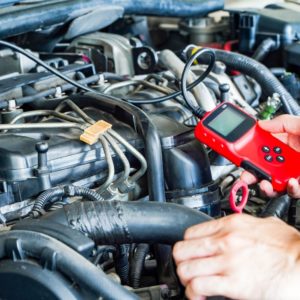Diesel engines produce power by injecting fuel into the engine’s cylinders and combusting it via the high temperatures achieved by compression. The amount of fuel pressure applied to the fuel injectors is critical, as it controls how much fuel is injected into the cylinders. If there are issues with the injector control pressure regulator, the powertrain control module (PCM) can store the P2623 code or other related trouble codes.
What Does the P2623 Code Mean?
Diagnostic trouble code (DTC) P2623 is defined as Injector Control Pressure Regulator Circuit/Open. This code is triggered when the PCM detects a problem with the injector pressure regulator or its circuit.

Fuel pressure regulators are responsible for controlling the pressure of the fuel that’s sent to the injectors. Code P2623 often applies to diesel-powered vehicles that have a hydraulic electronic unit injector (HEUI) fuel system. With such a set up, pressurized engine oil powers the fuel injectors. The injector control pressure regulator varies the pressure of the oil delivered to the injectors.
If the PCM detects a problem with the injector pressure regulator or its circuit, it may set code P2623.

Note: The definition of the P2623 code can be different depending on the vehicle manufacturer. Consult the appropriate repair manual or repair database for the exact code definition.
What are the Common Causes of the P2623 Code?
These are the most common issues related to the P2623 code:
- Faulty injector pressure regulator
- Circuit issues, such as a damaged wire or poor connection
- An issue with the PCM, such as software in need of an update

What are the Common Symptoms of the P2623 Code?
Your vehicle might exhibit the following symptoms when the P2623 code is stored:
How to Diagnose the P2623 Code
If your vehicle’s PCM has triggered the P2623 code, then the likely culprits are the fuel pressure regulator or its wiring. You need to confirm which part is faulty before performing any kind of repairs. This will probably involve doing a visual inspection and testing the concerned components, which might need special knowledge, tools, or training as these components are often hidden inside the engine bay.
Keep in mind that vehicle layouts and part designs vary, hence their respective repair procedures will also vary depending on the manufacturer. Diagnosing the concerned components might require special knowledge and tools.
How to Fix the P2623 Code
Before attempting to do any repairs, know that there isn’t a single solution for any DTC. This is because vehicle models can have different repair procedures. If you don’t have much experience troubleshooting DTCs, then we recommend leaving the task to a professional mechanic.
You can try to do the job yourself, but you need to make sure that you know vehicle-specific repair procedures before you get started. Luckily, this information is available online. Chilton repair manuals or a subscription to an online repair database like ALLDATA DIY can give you information on the correct diagnostic and repair procedure to clear diagnostic trouble codes like the P2623.
Any information provided on this Website is for informational purposes only and is not intended to replace consultation with a professional mechanic. The accuracy and timeliness of the information may change from the time of publication.


















